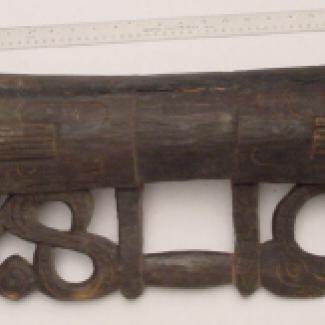This is a large ceremonial wooden drum of Asmat origin carved from sago wood. It stands quite tall and bears intricate carving decorations on its exterior. It features no paint and is dark brown with traces of smoke-induced patina. The drum forms an hourglass shape which culminates in a covered aperture at the top covered with lizard skin. The side of the piece features an elaborately carved handle with swirling geometric patterns and stylized cassowary beaks. The exterior of the main body features several raised carvings, symmetrical on the top and bottom. Inset into the wood are square-shaped carvings which frame the raised decorations.
Drums in Asmat society are highly associated with the popular origin myth of the Asmat people. Legend tells that originally there was a single human named Fumeripits. Fumeripits became lonesome and so he carved the likeness of humans from the wood of the sago trees around his home. But the forms were lifeless logs, with no emotions and no movement. So Fumeripits carved a drum and beat it to give his carvings life. This story, with variations based on community, forms the basic understanding of how people were brought into creation in Asmat culture.
In the modern day, drums are carved by hand from a single sago tree trunk by a single artist. They are used during the dedication ceremonies for a jeu (community house) and are central to daily life in Asmat society. When not in use, drums are placed above fire pits in homes, where they are preserved by the smoke. Over time, this smoke accumulates a thick layer of patina which gives drums a very dark coloration. Because of the sophisticated construction of drums, pieces such as this are intended to be used for a very long period of time before being retired.
Colors: Brown, Black

